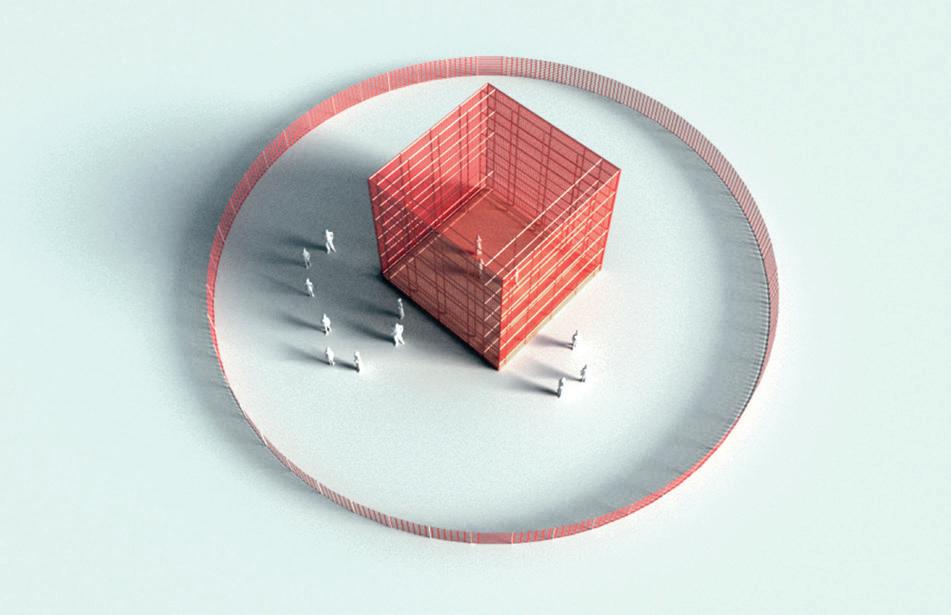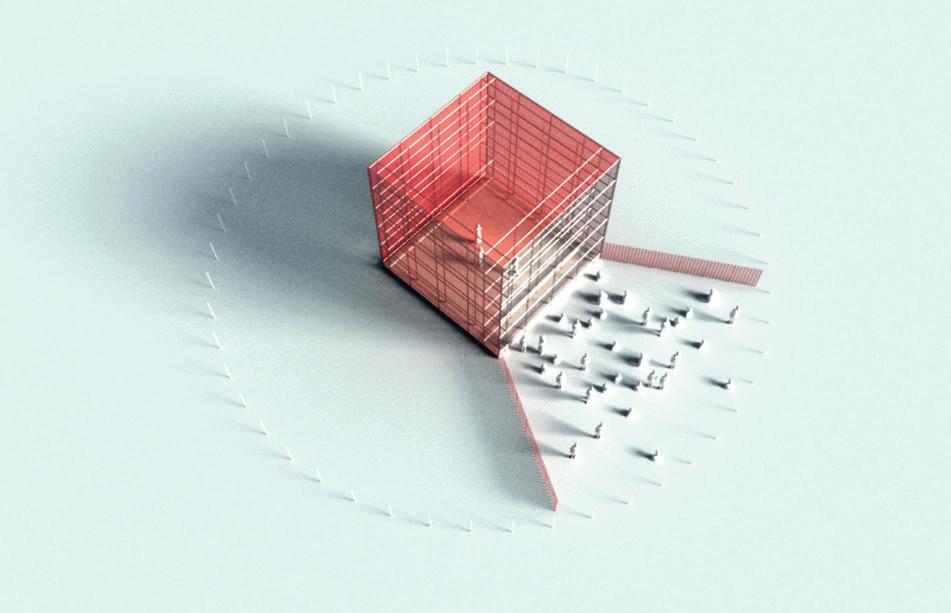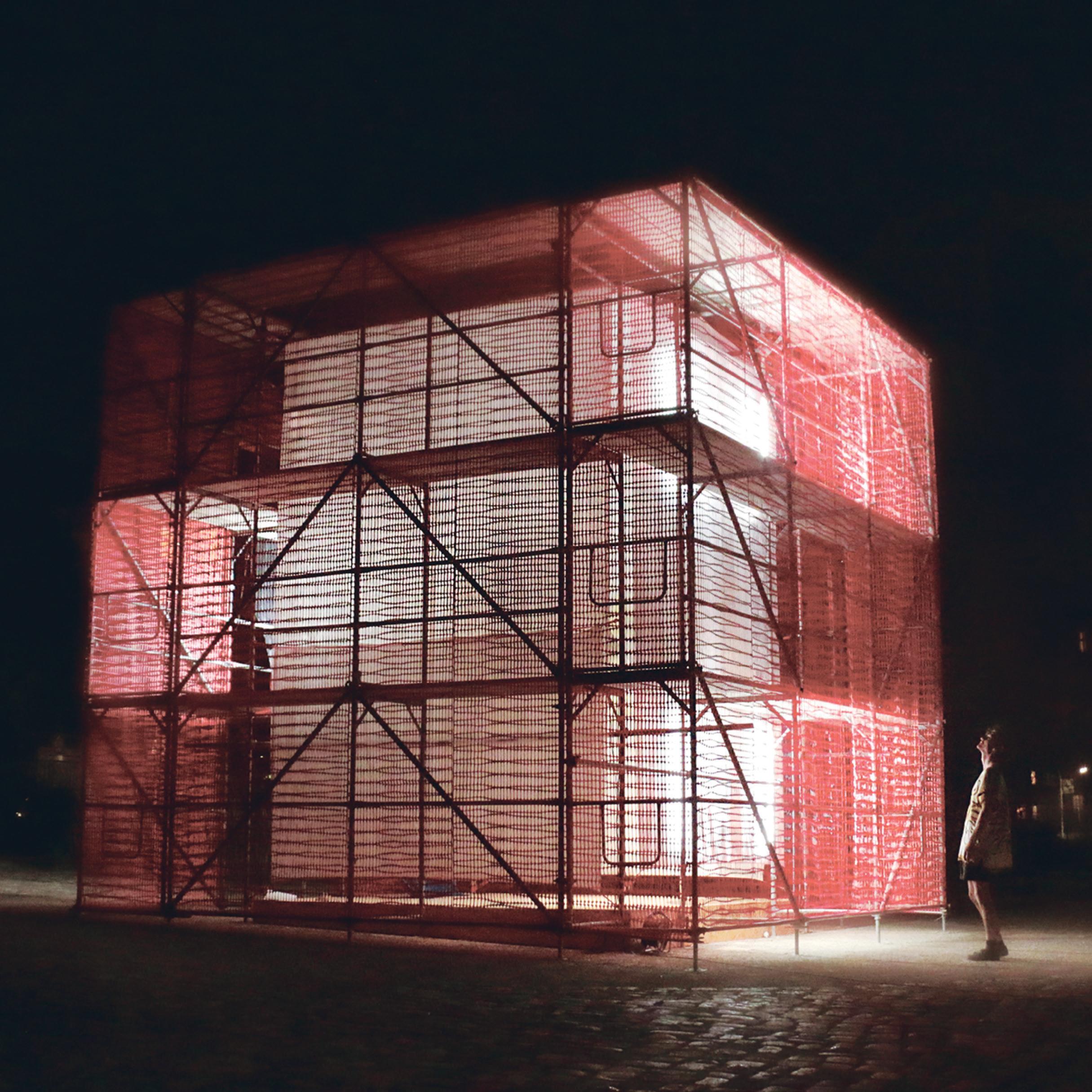
8 minute read
Ben Waters - Studio Osk: Stadtumbau
by A A D R
STADTUMBAU
A SPACE FOR ART + ARCHITECTURE EXPERIMENTS IN BERLIN
Advertisement
BEN WATERS - STUDIO OSK
In March 2014, Studio Osk designed a project that attempted what is often only spoken about in the abstract: transdisciplinary practice. We wanted to test how artists and architects could engage in the collaborative exchange of spatial ideas, as well as explore the transformative effects of art and architecture in the public realm.
Ultimately the project took our studio – a small Melbournebased studio made up of two architects and an artist – to Berlin, where we built a temporary pavilion to house events, performances and installations and sought out the potentials of cross-disciplinary exchange in this rich and vital context. We called the work Stadtumbau. Roughly translated as ‘city-restructuring,’ this term is more commonly deployed in Germany during the bureaucratic processes of urban design. But we wanted to invoke the term literally; we wanted to question what it was that traditionally restructured a city.
Our ambitions were strongly influenced by past collaborative projects between artists and architects within this context, namely the controversial Memorial to the Murdered Jews of Europe, conceived by architect Peter Eisenman and sculptor Richard Serra.1 The project provided us with the opportunity to test the potential of art and architectural interventions in public space, particularly in the context of Berlin as a liberal space for experimentation and transgression.
Two years on from the project’s completion, we have had the chance to reflect on the experience and consider some of the aspects that made this experiment both difficult and possible. This essay presents some of our musings on the process of devising and funding this transdisciplinary project, the importance of situated institutional support, and the critical nature of the socio-political space in which these projects are conducted.
Studio Osk, "Stadtumbau," pavilion, Stadtumbau art festival, Berlin, 2014. Photograph courtesy Studio Osk.

The Political Economy of Transdisciplinary Projects
As part of the residency program at the Centre for Art and Urbanistics (ZK/U) Berlin, we were invited to participate in a four month period of exchange, study and exhibition according to the conceptual framework of transdisciplinary practice. Part of the attraction of the project was the simplicity of the idea; a large, flexible and temporary pavilion that would house events, performances and installations by those in residency at the ZK/U.
But conventional funding methods were not available, so a crowdfunding strategy became the most viable approach for us to cover the travel and material costs of the project. This funding format meant we had to conceive and publicly promote a proposal before our trip, asking those in our expanded social network to support the project via donations. These donations were rewarded through a series of ‘gifts’ we pledged to provide, like artworks, photographs and communications from Berlin.
The very nature of the brief forced the architectural resolution of the project to be undefined and open-ended. We proposed an operable structure, designed from a universal scaffolding system in the form of a cube. The cube was to be clad in two layers of lightweight material; an outer skin of orange mesh and an inner skin of white canvas. That both layers of skin could be pulled up and over, in and around the scaffolding structure meant that we could reform the pavilion’s composition according to different events occurring within and around the structure.
This ability for the structure to open and close – and thus transform between theatre and arena, or gallery and stage – was the key strategy to allow for unknown future collaborations. A promotional video piece was produced for the crowdfunding campaign as an abstract demonstration of the cube’s transformative qualities. This stop-motion, watercolour animation proved engaging from the outset precisely because of its grounding within a traditionally fine art medium, yet with real architectural implications. This type of disciplinary interaction works well in the context of crowdfunding, as a broad audience can easily engage with this form of communication.
Thankfully, our idea and the campaign execution proved compelling enough for our social network to gather the funds necessary to support two architects and an artist on a relatively unknown pursuit; the 30-day crowdfunding campaign raised more than initially estimated for the project.
And so, we were off to Berlin.
The Institutional Context of ZK/U
The Centre for Art and Urbanistics (ZK/U) sees itself as a laboratory for transdisciplinary activities centred on the phenomenon of ‘the city.’ The ZK/U fellows list reads as a diverse classification of cultural disciplines; from the traditional (writers, fine artists, film makers) to the obscure (human ecologists, participatory sound artists, garbage architects). This unique setting allows for exchange between adjacent and newly established disciplines – of both local and international origin – through workshops, presentations, and a monthly open house exhibition.
The story of the ZK/U started almost 10 years ago when a group of artists called the KUNSTrePUBLIK established the Berlin Sculpture Park Central.2 KUNSTrePUBLIK reclaimed a piece of used land that was once occupied by the Berlin Wall and used it (without official permission or recognition) as a sculpture park. Forming their LANDREFORM project, they curated a series of works that challenged the idea of public space and arts involvement in the city. This work eventually culminated in the site being included as one of the official sites for the 5th Berlin Art Biennale in 2008.3 It was a very ‘Berlin’ condition; a major art biennale held on a piece of private land, without any formal permission.
In 2010, KUNSTrePUBLIK was awarded a €1 million grant from the German Bundesrat to develop a site in inner Berlin in Moabit, a working class suburb characterised by industrial zones, a port, and a century-old freight train line. KUNSTrePUBLIK proposed to renovate the freight train depot into a space for artists in residency, and surround the building with a new public park, in an attempt to revitalise the area with new public space containing not only art, but also the artists themselves.
The Socio-Political Context of Berlin
Berlin has long been a melting pot of people wanting to collaborate and to engage and experiment politically, socially and culturally. Its cultural vitality and social intensity produces a natural context for dialogue across different artistic and theoretical boundaries. The ZK/U is an archetypal manifestation of this condition; a place where those wanting to engage in this type of exchange can base themselves. An early point of reference for our project was the collaboration between Eisenman and Serra for the conception of the Memorial to the Murdered Jews of Europe. Eisenman’s interests in the transformative potential of formal architectural operations, combined with Serra’s concern for disruption and disjunction within public spaces, produced a work that challenges our expectation of the role of art and architecture in providing meaning and experience in
the city. Knowing that the confrontations created in this vast public memorial were possible in this city provided the initial conceptual intent for our project, as did the belief that we would find here too a willing and open community of potential collaborators from around the world.
That intuition proved correct: within a two month period we collaborated with nine different practitioners to produce works that sought new interactions with structure and material. One such work was French artist Natasha Mankowski’s installation of raw silk sheets, soaked in differing minerals and hung throughout the pavilion interior; the paintings themselves crossing over into the space of architecture. Another was a work created with Swiss-Italian artist Luca Forcucci. His sound recordings, taken from cities throughout the world, played through the cube’s steel scaffolding via speakers that transformed the structure into an acoustic resonator. Yet another – German artist Johanna Burnheart’s improvised film score (pictured over page), in response to a film by Studio Osk – similarly attempted to alter the traditional relationship between art and architecture.


A Platform for Collaboration
The inherently open-ended nature of such transdisciplinary projects means that conventional funding is often not available. But crowdfunding Stadtumbau has the benefit of negating standard client-stakeholder relationships, allowing our thinking of the project to be resolutely towards concept and collaboration.
This funding method raises critical questions about the potential for transdisciplinary projects to succeed within the context of traditional art and architecture funding regimes. Is crowdfunding likely to be the main source of funding for projects like this into the future? How sustainable is that likely to be, and what type of practitioners, practices and audiences are privileged and marginalised in the process if this is the case? These are important questions that we have yet to deal with in the political economy of transdisciplinary practices.

References 01 Hanno Rauterberg, Holocaust Memorial Berlin: Eisenman Architects (Baden, Switzerland: Lars Müller, 2005). 02 See Susanne Schröder, ed., Skulpturenpark Berlin_ Zentrum (Verlag, Germany: Walther König, 2010). 03 "The structure of ZK/U," Center for Art and Urbanistics ZK/U, accessed March 10, 2016, http://www.zku-berlin.org/about/.

Crowdfunding campaign diagrams. Studio Osk, Stadtumbau, 2014.
Studio Osk, "Stadtumbau," pavilion, Stadtumbau art festival, Berlin, 2014. Opposite: Johanna Burnheart and Studio Osk, "Moabit - Live Film Score Performance," improvised performance, Stadtumbau art festival, Berlin, 2014. Photographs courtesy Studio Osk.






